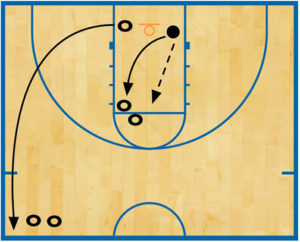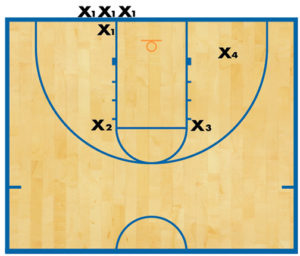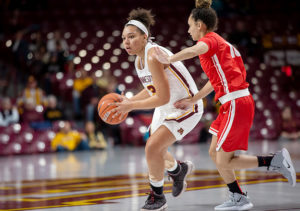Four drills for teaching motion offense
Motion offense is a key part of the Basketball Australia curriculum and philosophy, and it’s taught with a particular concentration in youth basketball. Motion offense teaches young players the importance of reading defenses, spacing the floor, timing, and is a tool to develop the basic fundamentals that all basketball players need to have.
The following are four highly effective drills that we often use during training sessions to teach motion offense principles, with an emphasis on the fundamental skill development in the athletes.
’30 Pass’ Drill
This is a great drill that can be done at the start of practice to warm up. It’s used to encourage communication, competition, and it follows a game-like approach to the following motion principles:
- Leading
- Cutting
- Sealing
- Passing
- Spacing
- Reading the defense
Set up with two teams of equal numbers, one ball and a coach who serves as the passer.
DIAGRAM 1: “30 Passes” Drill. The objective of this drill is simple — the first team to make 30 passes wins. This is a competitive drill, and there’s a penalty (usually sprints and push-ups) for the team that comes in second place.
Drill Rules: The offense (team O) keeps possession of the ball continuously unless it breaks one of the following restrictions:
- Dribbling the ball (there’s no dribbling allowed).
- Catching the ball and not being squared up.
- Putting the ball above their head.
- Passing with the incorrect hand (left hand for a pass to the left).
- Allowing the defense to touch the ball with two hands.
- Not counting out loud as a team.
The coach must watch closely for violations. Whenever one of these violations occurs, the possession is changed over to the defense (team X). The game resumes with an inbounds pass from the coach. Team O keeps track of its score and adds to it next time it gets possession. The first team to successfully complete 30 passes wins.
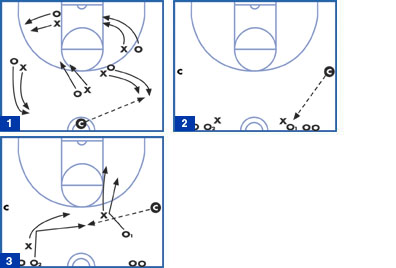 Drill variations: You can spice up the drill by adding in several rule changes such as:
Drill variations: You can spice up the drill by adding in several rule changes such as:
- Allowing the team with the ball one or two dribbles per possession.
- Adding three points to a team’s total score for any made layup.
- Allowing screens.
2-on-2, half-court drill
This is a competitive drill used to teach players how to the read the defense and make leads for the ball or back-cut to the basket. The emphasis of the drill can easily be changed toward the defense, but in this description we focus on the offense and the motion principles involved. It incorporates all the fundamentals of the previous drill in a very competitive environment.
Drill set-up: Have players form two lines at half-court. The first player in each line serves as a defender (X1 & X2), and the second player in each line begins on offense (O1 & O2). Two coaches line up on each sideline and serve as the passers. The first pair of players to score seven points wins.
DIAGRAM 2: 2-on-2, half-court drill (set up).
DIAGRAM 3: 2-on-2 half-court drill. The drill starts with a pass to either coach (on the sidelines). The offensive players are not allowed to use screening or dribbling, instead using spacing, timing of cuts and communication to get open and score.
The offensive players can pass the ball back to the coaches at any time, so essentially it is 4-on-2.
Drill variations:
- Allow one type of screen to be used, such as a downscreen or backscreen.
- Allow offensive players to use two dribbles each time they touch the ball.
- Allow on-the-ball screens.
Dribble-entry-and-post-up drill
A big part of motion offense is the ability to score from inside the paint. Passing the ball into the post can often lead to a good assist — or if it’s a bad pass, a turnover. The defense is generally aggressive in the post area, as it knows that you can get high-percentage shots inside.
The following drill breaks down the perimeter-to-post feed through a game-like approach. It’s also a great tool for teaching your players proper offensive stance, pass fakes, reading the defense, and sealing/re-sealing techniques.
Drill set-up: Have your players form two lines one at the half-court line, and the other on the sideline near the wing. The first player in each line is on defense (X1 & X2), and the second player in each line is on offense (O1 & O2).
Station one coach in the lane. He or she watches over the two offensive players and makes sure that they are using proper post-up and post feed techniques. Another coach is positioned along the baseline, and he or she is in charge of watching over the defenders and making sure they utilize proper post defensive techniques.
The offensive players must use a dribble entry, recognize the defense, and make the appropriate feed into the post. The post players must catch the pass and make a good post-up move.
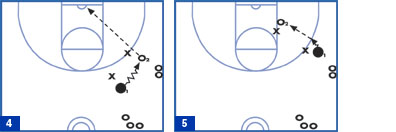
DIAGRAM 4: Dribble-entry-and-post-up drill (set up).
DIAGRAM 5: Dribble-entry-and-post-up drill. The drill starts with a dribble entry to the wing. The wing player makes a back cut to the basket and posts up on the block. Encourage the passer to re-locate on the perimeter.
Penetrate-and-pitch drill
This drill is an important part of any motion offense. It encourages aggressive ball handling toward the basket, forcing the defense to make adjustments, and for both the dribbler and off-the-ball players to create space and make reads of the defense.
Drill set-up: The initial set up is the same as in previous drill. The first pair of players to score three points wins. Penetration can come from the point or wing positions toward the middle of the court. Build to 3-on-3 by adding a weak-side post player.

DIAGRAM 6: Penetrate & pitch drill (A). This diagram shows an example of where the help defender has hedged early, and as there is no ball-side post, there is space for a basket cut (shaded area) by O2.
DIAGRAM 7: Penetrate & pitch drill (B). This diagram shows an example of when the help defender has helped late, and there is space behind the penetration to fill (shaded area).

